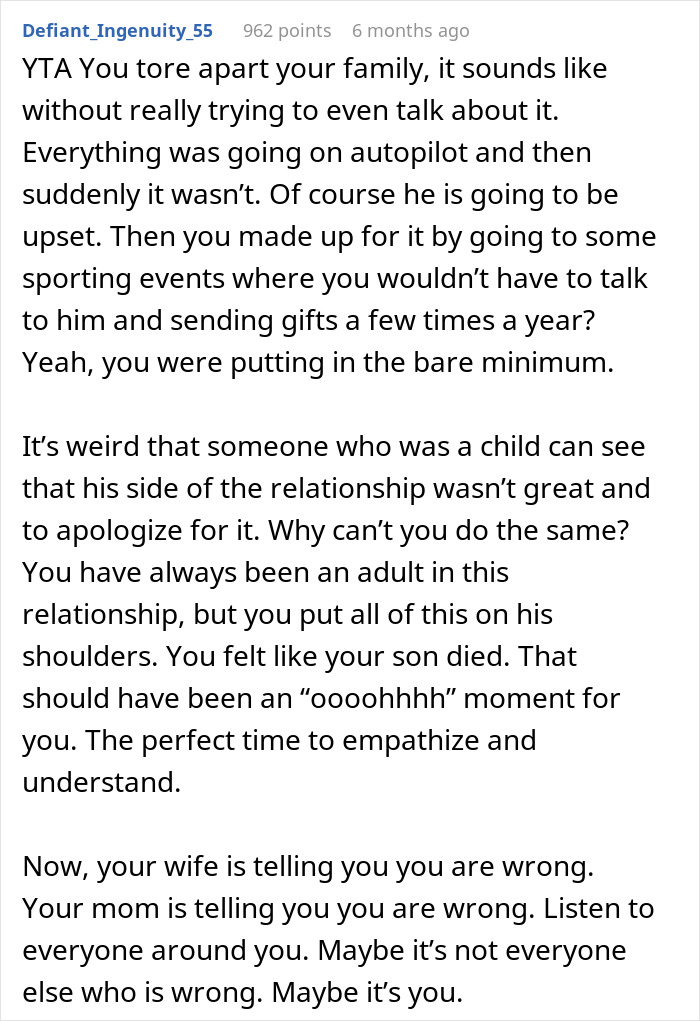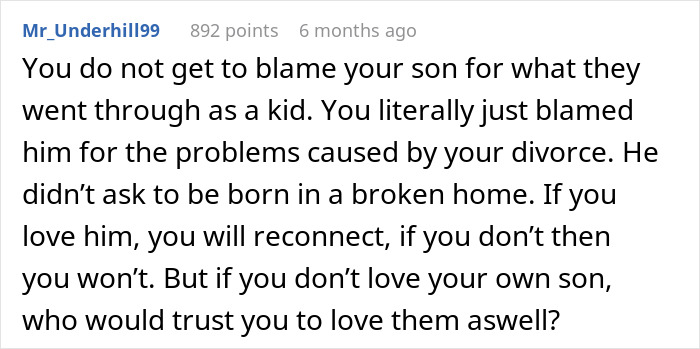Although heartbreaking, family estrangement is quite a common occurrence. Research shows that 27% of Americans have a family member they have no contact with. And it’s not necessarily parents and children. Rifts between siblings happen, too. After years of not talking, people find it hard to reconnect: “What if the other person hates me? What if they (or I) can’t forgive?”
The author of this story found himself in a similar situation. The Redditor u/Longest-Journey had a son who wanted to reconnect. But the OP felt that there was too much hurt and pain and found himself unable to do it. So he asked other netizens to weigh in.
To know more about family rifts and how to repair them, Bored Panda reached out to Fern Schumer Chapman. She is the author of several books, including Brothers, Sisters, Strangers, and The Sibling Estrangement Journal. She offers private, one-on-one coaching sessions to those who struggle with sibling estrangement issues, as well.
More info: Fern Schumer Chapman | Facebook | Instagram | LinkedIn | Twitter
Divorce can be tricky when there are children involved

Image credits: Jakob Owens / Unsplash (not the actual photo)
This father found himself unable to reconnect with his estranged son due to past guilt and resentment





Image credits: YuriArcursPeopleimages / Envato Elements (not the actual photo)
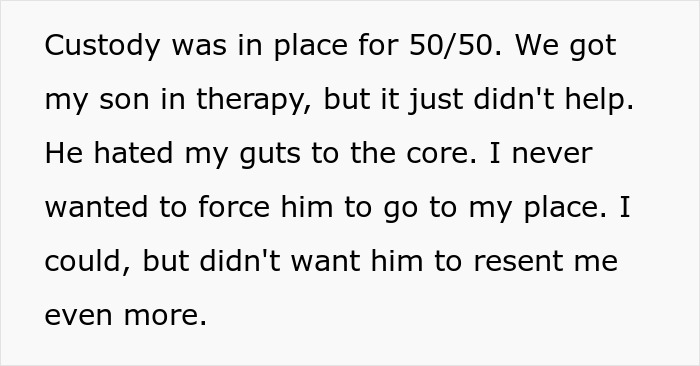




Image credits: Andrik Langfield / Unsplash (not the actual photo)



Image credits: Erik Mclean / Pexels (not the actual photo)





Image credits: Torsten Dettlaff / Pexels (not the actual photo)




Image credits: Longest-Journey

Image credits: cottonbro studio / Pexels (not the actual photo)
Staying connected with family members matters
The situation OP describes here is undoubtedly difficult and painful for all family members. The then-pre-teen son’s reaction to his parents’ divorce might seem overboard, but the now-adult son seeks reconciliation. Bored Panda asked Fern Schumer Chapman to explain why estranged family members feel the need to reconnect even after years of resentment and hurt feelings.
“Humans have a deep need to belong,” the author says. “The eminent psychologist Abraham Maslow identified this crucial need in his ‘Hierarchy of Needs,’ a color‐coded, weighted pyramid of basic human requirements.”
“The need to belong—whether through family, friendship, shared interests, or sexual intimacy—ranks just after the essentials: food and water, shelter and sleep, physical safety. Like these fundamentals, the human need to belong is lifelong.”
“[If you] absent a sense of belonging—this feeling of emotional safety and context—people come to fear that their very lives are at risk. They lose the ability to trust and connect with others, instead becoming consumed by the task of surviving alone.”
“The family—that original constellation of relationships—offers an opportunity to belong to a group and a chance to develop deep, lifelong connections that may transcend the transient nature of our existence,” the expert on family estrangement explains.
Image credits: Engin Akyurt / Pexels (not the actual photo)
Those who want to reconnect with a family member should consider these six steps
The author of The Sibling Estrangement Journal says that a person should examine their feelings in great detail before trying to resume a relationship. She says the person should ask themselves these questions:
- Why is this relationship important to me, not to my family or to anyone else but to me?
- Does my family member want to resume a relationship?
- Can I set aside the anger, pain, and/or resentment that led to the break to change our pattern of relating?
- Do I want to resume this relationship if I discover that neither of us have changed?
- Do I have the time, energy, emotional resilience, and support of other loved ones to reconcile and rebuild this relationship?
- Will I compromise too much of myself if I try to sustain a relationship with my difficult family member?
Image credits: Priscilla Du Preez / Unsplash (not the actual photo)
What to say and what not to say when trying to reconcile with an estranged family member
When a person has weighed the ins and outs of their decision, it’s time to act. But you can’t just simply walk to their door and ring the bell, can you? Fern Schumer Chapman suggests looking at the confrontation as if it was a dispute. She suggests a strategy from Dr. Donna Hicks, an associate at the Weatherhead Center for International Affairs at Harvard University.
“[Hicks] has worked as a third-party facilitator in some of the world’s most intractable conflicts [and] has drawn upon her experiences mediating international disputes to create a model for communication that applies to families as well as to nations,” Chapman tells Bored Panda.
“Dignity, she explains, invests each of us with an inherent value and worth. When individuals are denied their dignity, they feel inconsequential and irrelevant, and they become enraged and resentful that they are not seen or heard,” Chapman goes on.
The person then might start asking questions like, “How can you treat me like this?”, “Can’t you see we are human beings?”, “Can’t you see we are suffering?”
The four steps to resolve such a conflict, according to Hicks, include:
- Sitting down together face to face.
- Listening without interrupting and challenging each other’s stories. “The one goal is to seek understanding. Experts agree that reconciliation is impossible without true, genuine listening,” Chapman emphasizes.
- Acknowledging that the other person hurts, is angry, or alienated and empathizing with them. “Give them the benefit of the doubt; assume they have sincere, trustworthy intentions. When each party accepts both parties’ experiences, neither feels devalued or shut out,” Chapman adds.
- Stressing and acting on your willingness, desire, and hope to create a mutual bond.
- And, lastly, letting go of anger.
Commenters reacted to OP’s story and pleaded with him to give his son a second chance



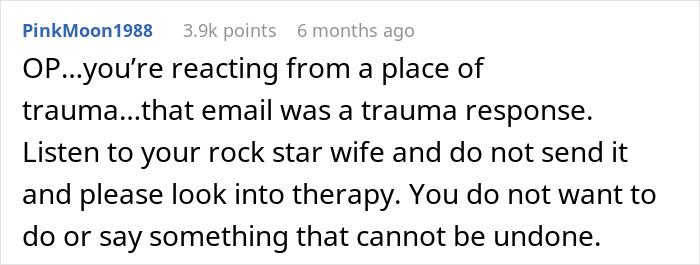

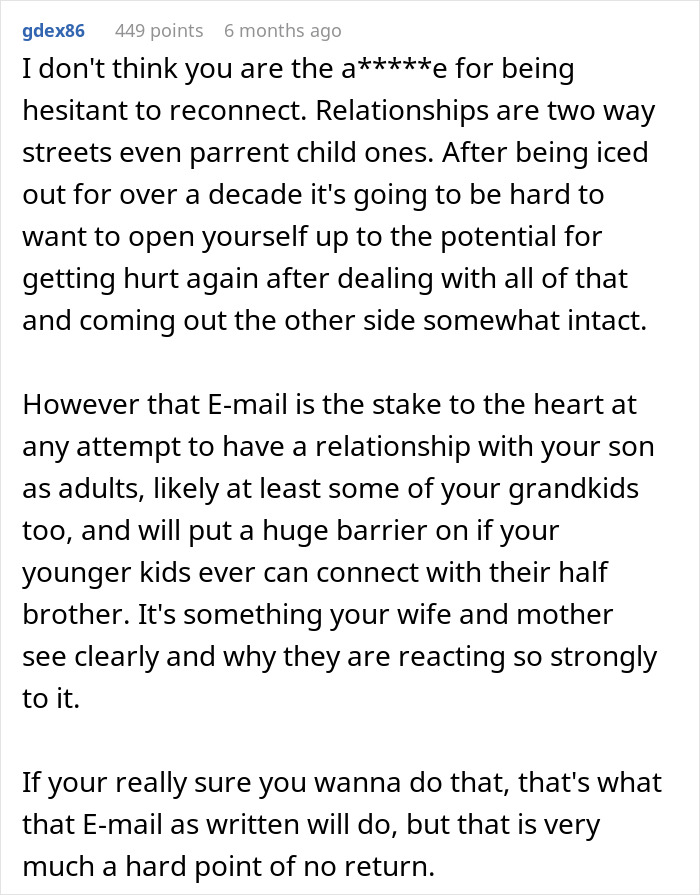
Many other netizens called the OP a jerk


